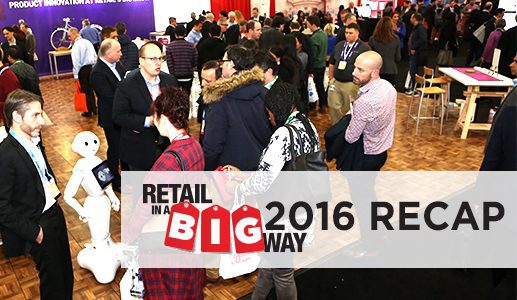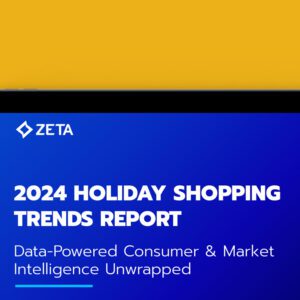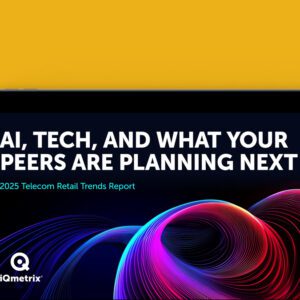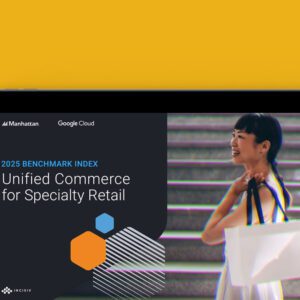Positive vibes reverberated throughout the vast exhibit halls and session spaces during #NRF16. Retailers, solution providers and industry analysts all seem ready for an exciting, disruptive and innovative year.
The six members of the Retail TouchPoints editorial staff also felt this vibe. Here are the key themes, lessons learned and Quick Tips from our insiders’ perspectives:
 Debbie Hauss, Editor-in-Chief
Debbie Hauss, Editor-in-Chief
Data Update: You Know How To Use It!
For years we’ve been talking about the fact that retailers have so much data at their disposal, but they don’t know how to effectively collect it, analyze it and put it into action. Good news in 2016: Many retail organizations finally have figured out how to break down the data silos and develop successful strategies that are tapping the same information across business units.
Here are just a few examples of solutions discussed during #NRF16 that are answering this call:
-
Predictix recently received a $25 million investment from Infor; these partners are helping retailers like Whole Foods access advanced analytics in the cloud.
-
Shoppertrak, just acquired by Tyco Retail Solutions, introduced an advanced analytics platform that offers peer grouping, data visualization, dynamic targeting and much more.
-
Esri is delivering highly detailed location data down to the zip code that can help retailers decide where to open new stores, which products to sell in each store, and how to market to the most prevalent demographic group in each region. The company’s geographic information systems (GIS) help retailers like Petco make the right real estate decisions.
Quick tip: When choosing an analytics partner, retailers need to ask the right questions to find out if the solution provider can help solve their specific business problems or challenges.
 Alicia Fiorletta, Content Strategist
Alicia Fiorletta, Content Strategist
Retailers Get Real About Innovation
At last year’s NRF BIG Show, there was a lot of talk about the convergence of digital and physical and even more buzz around the Store of the Future.
I wouldn’t say the excitement has faded. Companies like Intel and Samsung had impressive booth displays that showed how technology can augment the store experience.
However, it seems like retailers are being more realistic about how they embrace innovation. As I was told during a meeting with Cisco: “Retailers need to fail fast, but learn faster.”
During my conversations with companies like Tyco Retail Solutions, I also learned that retailers are being more strategic with their technology investments. They are thinking long and hard about whether new touch points will add value to customer experiences.
For example, I saw a compelling display on the show floor from Perch. When I picked up a container of lotion, the display was triggered and I was able to access a variety of content, including product details, reviews and educational videos. This is what I consider to be a super cool solution, but it will not be a fit for every retailer.
I’m excited to see how retailers take a more practical approach to innovation, and how they find the right technologies for their businesses.
Quick tip: Think critically about how the tech aligns with your brand image and story; how it will make your customers’ lives better/easier; and how it will help you reach a strategic business objective.
 Adam Blair, Executive Editor
Adam Blair, Executive Editor
The Swiss Army Knife Model: Versatile Multi-Use Solutions
Discovering devices and software with multiple use cases built in was a pleasant surprise at the 2016 Big Show. Like the screwdriver-corkscrew-scissors-secret decoder ring hidden within the Swiss Army Knife, solutions providing more bang for the retailer’s buck are a “win” when stores, and the associates working in them, are being called on to perform many new tasks.
Electronic shelf labels from Displaydata not only provide a signboard for dynamic pricing and expanded product data, they can also double as beacons that interact with mobile devices. After hours, they can be “flipped” for a third purpose: alerting associates about needed actions for the product, such as restocking.
Wavelink has partnered with hardware manufacturers to create devices that can manage up to four separate applications, switching between keyboards customized for each application’s data entry requirements. An added benefit is reduced training time and greater assignment flexibility for those trained on a single device.
Printers from Brother Mobile Solutions that interact with mobile POS solutions, print receipts and perform additional duties as label printers are another example of multi-function devices working hard in the retail environment.
Quick tip: It’s vitally important to treat employees as customers, since they are front-line brand ambassadors. Moving to this mindset — and taking practical steps to ensure it’s more than just lip service — can help retailers deal more effectively with labor challenges while also creating a more pleasant, productive workplace.
 David DeZuzio, Managing Editor
David DeZuzio, Managing Editor
Streamlined Shopping, Data Piles And Talking Shoes
While most industry executives I spoke with were tired of the term “omnichannel,” they were interested to know if any company successfully achieved it. It looks like 2016 will be the year seamless “overused term here” experiences will reign.
Elo is offering cloud-based solutions featuring interactive touchscreen POS and mPOS systems, self-service kiosks and digital displays that range from seven to 70 inches. Consumers will have the convenience and interactivity of online shopping in-store, and sales associates, armed with real-time stock inventories, won’t have to go to the back to see what’s available and waste the consumer’s time. Look good, runs good.
Added to this mix comes the distillation of the massive amounts of data being collected. Foot traffic, product hotspots, customer identification, facial recognition and a myriad of granular facts are being tracked and collated in real time to show retailers what their shoppers are up to, and what is selling. Prism and Optimove are helping retailers get the most out of their information, plan effective strategies and improve loss prevention capabilities.
Smartrac’s washable RFID technology enables your sneakers to let you know it’s time to run and where your running partners are meeting up. Very cool, but might take a little getting used to.
Quick tip: While data collection is important, don’t forget that a great discount always works — it has nothing to do with past purchases or the day of the week. Also, avoid making interactive clothing too creepy; I am not sure I want my shirts to tell me when it’s time to wash them.
 Glenn Taylor, Associate Editor
Glenn Taylor, Associate Editor
In This Data-Driven Industry, It’s All About Context
It’s no secret: With the growing presence of e-Commerce and mobile device usage in the store, in-store analytics is a significant challenge for all retailers looking to measure new trends’ effects on store performance. However, while measuring in-store data has become a retail imperative in 2016, companies need to get their hands on both ‘how’ and ‘why’ this data is important to their specific business.
March Networks is a great example of a solution that showcased these ‘how’s’ and ‘why’s’ in the store, serving as a loss prevention and video surveillance platform that tracks how long a consumer is in line, and even collects in-store audio if necessary.
In terms of making this data contextual and actionable, the Gimbal team’s further deployment of proximity beacons in stores has shown that retailers are getting a better idea of the context behind specific in-store data. Jeff Russakow, the company’s CEO, explained to me that part of the reason beacons haven’t flourished on the scale expected from them two years ago was that many retailers are still getting used to understanding where this data is coming from and how it could best be utilized.
Quick tip: While data gathering is important, businesses need context layered in, in order to understand store performance and optimize all channels.
 Klaudia Tirico, Associate Editor
Klaudia Tirico, Associate Editor
Retailers Are Thinking Outside The Box Of Traditional Ads
At #NRF16 I noticed that more retailers are thinking outside the box of traditional advertising, with user-generated content and influencer marketing. Social media gives consumers an environment where they can see how like-minded individuals are using products in real life, as opposed to staged catalogs and print ads.
Demandware demonstrated how their partner Olapic could create an online community for brands through user-generated content. NYX Cosmetics is using Olapic to collect thousands of user photos through hashtags and ask for the rights to use their photos. The user can reply to the brand via their Instagram photo to accept or deny.
“On average, seven out of 10 individuals reply ‘yes’ to the brand with no monetary compensation,” said Ashley Smith, Sales Director at Olapic.
With permission from the shopper, NYX is able to use the photo in marketing materials: in emails, on the e-Commerce platform, on digital displays in brick-and-mortar stores, and beyond. That’s a lot of free promotional imagery for brands to use as advertising.
An NRF session about how brands use influencer marketing to generate buzz and increase marketing ROI featured speakers from Pottery Barn and Clever Girls Collective. You can read more about how influencer marketing can connect your brands to shoppers here.
Quick tip: Don’t let your small budget deter you from finding creative ways to promote your brand. Consumers and influencers are excited to be a part of the conversation, so include them! It doesn’t have to cost you big bucks.




 Alicia Fiorletta, Content Strategist
Alicia Fiorletta, Content Strategist Adam Blair, Executive Editor
Adam Blair, Executive Editor David DeZuzio, Managing Editor
David DeZuzio, Managing Editor Glenn Taylor, Associate Editor
Glenn Taylor, Associate Editor Klaudia Tirico, Associate Editor
Klaudia Tirico, Associate Editor









